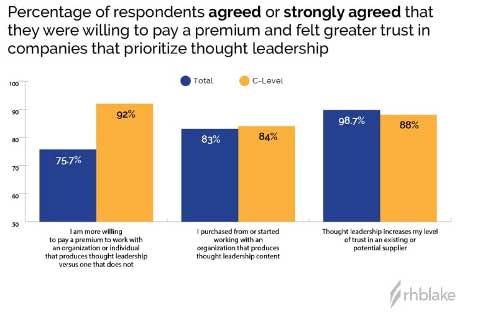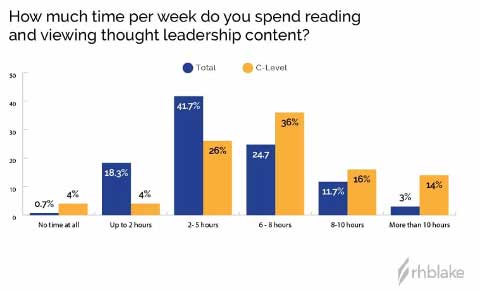Thought leadership is more than just another marketing tactic. It’s a strategic investment that delivers tangible financial returns.

By Dan Konstantinovsky
In a business environment flooded with information, content that helps customers and prospects learn something new and valuable is critical for cutting through the noise and improving business outcomes. This is particularly true for marketers of offerings with long sales cycles (LSC) in the manufacturing ecosystem, where decisions involve high investment, complexity and far-reaching organizational impact.
These marketers face distinct challenges, including capturing market attention amidst AI-generated content, overcoming buyer skepticism (evidenced by a rise in the keyword “legit”), navigating ever-larger buying teams, and addressing buyers’ preference for a seller-free experience. Thought leadership serves as a powerful solution to these daunting challenges, enabling manufacturers to influence changing buying behaviors and better support their salespeople.
One of the most compelling returns on investment (ROI) for thought leadership is its direct impact on margins by influencing pricing. The RH Blake 2025 Thought Leadership in Manufacturing Report, based on a survey of 300 manufacturing buyers and decision-makers, reveals that 76% of decision-makers are more likely to pay a premium to work with an organization that consistently produces thought leadership content. This willingness demonstrates that marketers can do more than just build awareness and preference. Their efforts can improve bottom lines.

For B2B manufacturers, thought leadership is content that delivers expertise, guidance or a unique perspective on a professional topic or field, such as technology, business processes or industry trends. Its core purpose is to help customers and prospects learn something new and valuable, enabling manufacturers to cut through the noise in a world flooded with information, including that generated by AI.
This is particularly crucial for marketers of long-sales-cycle offerings in the manufacturing ecosystem, where buying decisions involve high investment and complexity. Unlike mere advertising or promotional literature, thought leadership aims to improve business outcomes by influencing changing buying behaviors and better supporting salespeople, even as buyers increasingly prefer a seller-free experience.
Good thought leadership is based on real-world experiences, case studies, and examples, supported by strong research data, and communicated by recognized industry experts. Common formats include articles, blogs, podcasts, presentations, research reports, videos (such as YouTube), webinars, and whitepapers.

The impact of thought leadership is even more pronounced at the C-level, the ultimate holders of purse strings and veto pens. A notable 92% of C-suite respondents are willing to pay a premium for organizations producing thought leadership. This heightened value among senior decision-makers underscores thought leadership’s role in fostering trust and protecting price and margin, especially with executives.
Executives dedicate significant time to consuming such content, with more than 66% spending over six hours weekly, and 30% spending eight or more hours, indicating a strong appetite for this material. Their preferences lean towards content communicated by recognized industry experts and supported by strong research data, rather than ideas still being formed or merely unique perspectives.
Beyond direct pricing influence, thought leadership that is part of an integrated marketing program profoundly affects brand perception and trust, which in turn justifies higher value. The study showed that 92% of decision-makers think more positively of organizations that consistently produce thought leadership content. Furthermore, 90% of decision-makers say that thought leadership increases trust in existing or potential suppliers. This establishment of credibility and expertise leads to buyers being more likely to consider organizations that produce high-quality thought leadership, thus restricting marketplace consideration for companies that do not. Thought leadership also facilitates sales engagement, making decision-makers more receptive to sales outreach from an organization that produces such content, even when many buyers prefer not to meet with onsite salespeople.
Thought leadership’s power extends to challenging the status quo and gaining market share. A significant 81.67% of total respondents and 93% of C-level respondents indicated that thought leadership has led them to realize there are other suppliers that are smarter, more informed, or more visionary than their current ones. While customers may not immediately drop existing suppliers, this realization is the crucial first step in building a meaningful relationship. For C-level executives, this effect is even stronger, with their willingness to end or significantly reduce work with a supplier being 12 points higher than the total respondents, demonstrating that your chance of displacing a competitor improves the higher up the customer organizational chart your thought leadership goes.
Thought leadership content is utilized throughout the entire buying journey, with its influence peaking in the Consideration stage (75.33%) and the Decision stage (72%). C-level leaders, in particular, rely more heavily on thought leadership during the Decision stage, emphasizing the need for data-driven, solution-oriented content that builds trust and confidence. This widespread use across stages means that consistent, high-quality thought leadership continuously reinforces value perception, supporting the ability to command premium prices.
Ultimately, thought leadership is more than just another marketing tactic. It’s a strategic investment that delivers tangible financial returns. It opens eyes, doors, and wallets. By providing content based on real-world experiences, case studies, and examples—which 93% of decision-makers deem important—and leveraging strong research data, manufacturers demonstrate their expertise. This strategic approach ensures that your firm’s expertise translates directly into increased perceived value, securing higher margins and enhanced profitability. Just as a meticulously crafted product commands a higher price through its demonstrated quality and superior performance, high-quality thought leadership justifies a premium by showcasing your organization’s intellectual capital and proven value.
About the Author
Dan Konstantinovsky is Strategy Director at RH Blake, a top manufacturing marketing agency based out of Cleveland, OH.
In this episode, I sat down with Beejan Giga, Director | Partner and Caleb Emerson, Senior Results Manager at Carpedia International. We discussed the insights behind their recent Industry Today article, “Thinking Three Moves Ahead” and together we explored how manufacturers can plan more strategically, align with their suppliers, and build the operational discipline needed to support intentional, sustainable growth. It was a conversation packed with practical perspectives on navigating a fast-changing industry landscape.